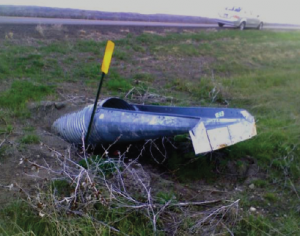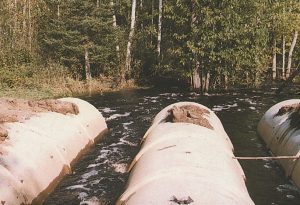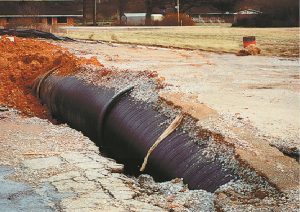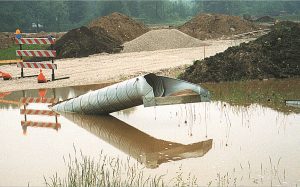It’s no secret that concrete pipe is one of the most reliable products to resist flotation. In heavy rainfall or catastrophic flooding situations, concrete’s density keeps pipes in place against upward, buoyant forces.
While flexible pipes are used in infrastructure projects as sewers, culverts and drains, these lower density products require much deeper cover and anchoring than concrete to provide adequate resistance against flotation – a commonly misunderstood principle, where flexible pipes receive inadequate ground cover.
The light weight of lower density products such as plastic or metal can become a hazard when the in-service pipe is exposed to water and doesn’t have the correct amount of ground cover.
A general rule of thumb is flexible pipe requires as much cover over the top as its diameter. For example, a 4-foot diameter flexible pipe will need 4 feet of cover to remain. By contrast, concrete pipe’s mass allows it to be buried with less ground cover than flexible pipes.
Buoyancy forces can cause installed pipe to float out of position in a variety of conditions:
- a high groundwater table;
- where flooding is used to consolidate backfill; or
- natural flooding.
Generally, only flexible, low-density pipe products such as plastic or metal are vulnerable to flotation failure, which can cause the outlet or inlet ends of the barrel to rise and bend (Federal Highway Administration, Hydraulic Design Series 5).

In some cases, flexible pipe culverts have jetted from the roadway. In worst-case scenarios, culverts have collapsed, taking the road surface with them.
Creating a stable pipe network is especially important considering that roadways not only serve our day-to-day transportation needs but become critical evacuation routes during natural disasters. Concrete pipe is a proven solution because, in most cases, concrete will not float.
The Power of Water Is Impressive!
Density is the secret to concrete pipe’s resistance to flotation. The average density of concrete pipe is 150 pounds per cubic foot—which is 2.4 times that of water! In an example case where the concrete pipe is 24 inches in diameter with 2 feet of earth cover (and groundwater table near the surface), its downward force is approximately 1.6 times greater than the upward (buoyant) force, meaning the pipe will not float.
Lighter-weight plastic pipes, however, almost always have densities less than water. Even with aggregate backfill, which improves the downward force, lighter-weight plastic pipes in many cases require an excessive amount of cover to provide adequate resistance against upward forces.
Buoyancy forces should be a design consideration during a project’s engineering phase. What’s more, engineers should check to ensure their pipes – whether flexible or rigid – are installed properly and have the correct amount of ground cover to protect the public from the dangers of floating, flexible pipes. All too often, pipelines remain unchecked following installation, causing the potential for future problems with flexible installations. If engineers don’t inspect their pipelines, they face the likelihood of expensive failures that may be difficult to repair.
Here’s a resource for checking your concrete pipe.
The Proof Is in the Pictures
Engineers can minimize their risk of floating pipes by choosing reinforced concrete. Concrete literally outweighs its competition: water. These visual examples tell the story.
 Minnesota: Three reinforced concrete culverts were installed under a gravel roadbed in northern Minnesota. Even though an intense storm event caused an abnormally high amount of rainfall, causing the gravel roadbed to wash away, the concrete pipe remained in place because of its weight. This allowed quick replacement of the roadbed and vehicle access to the area.
Minnesota: Three reinforced concrete culverts were installed under a gravel roadbed in northern Minnesota. Even though an intense storm event caused an abnormally high amount of rainfall, causing the gravel roadbed to wash away, the concrete pipe remained in place because of its weight. This allowed quick replacement of the roadbed and vehicle access to the area.

Michigan: Flooding may wash away the road, but concrete pipe remains intact and doesn’t float.
 Chattanooga, Tenn.: Even though it was full of water and had a cover of 12 inches of crushed stone, a 48-inch-diameter corrugated polyethylene pipeline floated out of the ground three times. When the developer revealed plans to use HDPE pipe in lieu of concrete pipe, the engineering firm requested in writing to be released from any responsibility and liability. Therefore, the expenses of reinstallation of the HDPE pipe were borne by the developer and the contractor.
Chattanooga, Tenn.: Even though it was full of water and had a cover of 12 inches of crushed stone, a 48-inch-diameter corrugated polyethylene pipeline floated out of the ground three times. When the developer revealed plans to use HDPE pipe in lieu of concrete pipe, the engineering firm requested in writing to be released from any responsibility and liability. Therefore, the expenses of reinstallation of the HDPE pipe were borne by the developer and the contractor.

Waukesha, Wis.: A 24-inch-diameter corrugated metal pipe was installed under the entrance to a new housing subdivision. Heavy rains and runoff from the construction site and the surrounding area caused one end of the pipe to float out of the ground. The pipe had approximately 30 inches of cover.
Specify concrete pipe to improve the serviceability—and safety—of your project. Remain vigilant in checking installed pipes – especially flexible pipes – to ensure ground cover is adequate.
